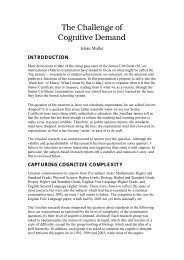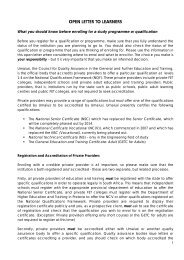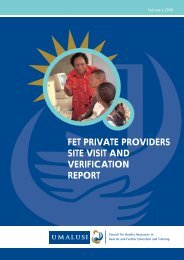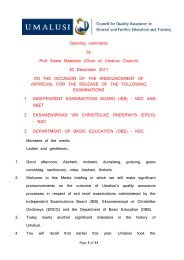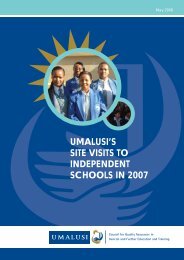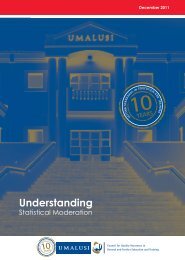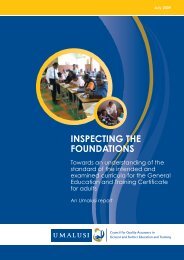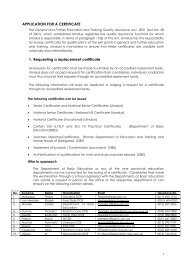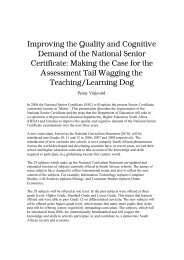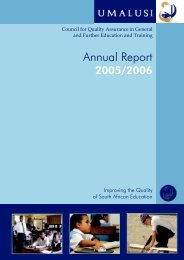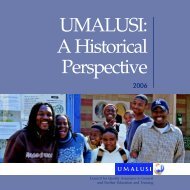Umalusi AET Report
Umalusi AET Report
Umalusi AET Report
- No tags were found...
You also want an ePaper? Increase the reach of your titles
YUMPU automatically turns print PDFs into web optimized ePapers that Google loves.
accredited and who is not. These issues will need to be addressed through current, transitional andfuture decisions.5.4 COMMUNITIES OF PRACTICEThe concept of communities of practice, sometimes referred to as communities of trust, is anongoing theme in debates on the development of the South African NQF. Essentially it is invoked asa conceptual tool through which to explore how a shared sense of professional standards can bedeveloped, so that portability of learning and articulation of credits can be enabled. The notion of“communities of practice” informs <strong>Umalusi</strong>’s approach to quality assurance in some ways, by theidea of peer review – a model in which those who themselves work in a particular sector are seenas the best people to make judgements about institutional practices in that sector. To this end,those appointed as monitors and evaluators are required to have some experience or knowledgeof the sector, and are often involved in the sector.This approach seemed to work in the <strong>AET</strong> sector, compared with experience in other sectors. Mostprovider sites in the evaluation sample readily reported on the existence of informal partnerships,with expertise and advice as the most common type of shared support. The data specifi callyrelated to assessment also revealed much sharing of information and expertise. There was alsosome sharing of facilities and equipment. Many of the sites named were other private <strong>AET</strong> providersas informal “partners” suggesting that there is evidence of a community of practice in the sense ofsharing of professional expertise. If <strong>Umalusi</strong>’s accreditation approach aims at fostering the idea ofbuilding up communities of practice in this sector, it will need to foster and encourage what exists inthis context.5.5 SHORT-TERM VIEWOne of the biggest challenges to the sector and possibly the factor which may hinder quality ofprovision the most is the very short-term view or very short lifespan of any project. The majority ofpractitioners in the sector (77%) are contract workers without tenure, leaving the sector without ahub of permanent professionals. Most sites have contracts for 24 months. And only fi ve providers inthe sample had contractual agreements for more than three years. This severely affects long-termplanning and serious career and learning path development for both learners and practitioners.Most learners in the sector study part-time, a relatively slow learning process which requires longtermmanagement and planning.5.6 QUALITY ASSURANCE CONCERNS<strong>AET</strong> providers are fragile and operate in diffi cult and unpredictable environments. The best <strong>AET</strong>is characterised by the quality of its responsiveness to contextual needs. The use of the standardprocesses for accreditation of independent schools and private FET providers may not be entirelysuitable to this sector. Even in those somewhat more stable sectors, the detailed provision ofinformation and preparation for site visits comes on top of other statutory registration and reportingobligations and could prove intolerably burdensome.It is unfortunately possible that contextually sensitive, award-winning <strong>AET</strong> centres with admired trackrecords going back years can be – and are – refused accreditation because they do not fi t into apredetermined mould. This would not necessarily be problematic if it did not threaten their accessto funding or their ability to prepare adult learners for assessment for registered qualifi cations.5.7 SUMMING UPThe profi les and the site visit verifi cation process certainly deepened <strong>Umalusi</strong>’s understanding of thecharacteristics of private provision in <strong>AET</strong>, the nature of these providers, and some of the challenges29



